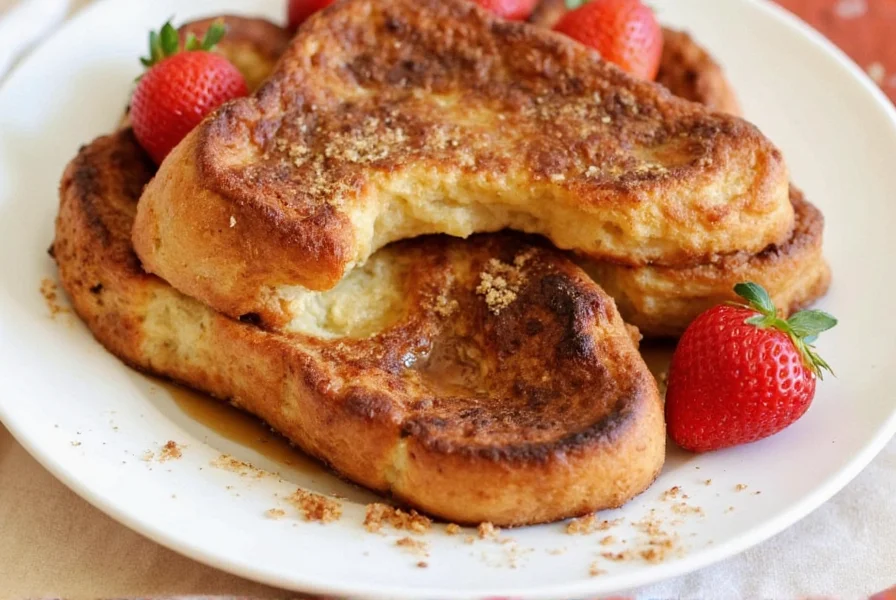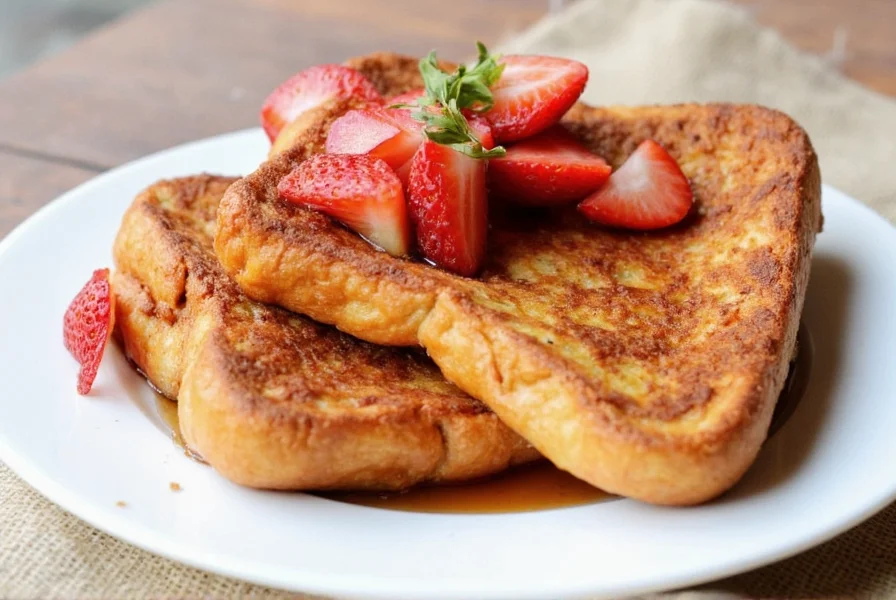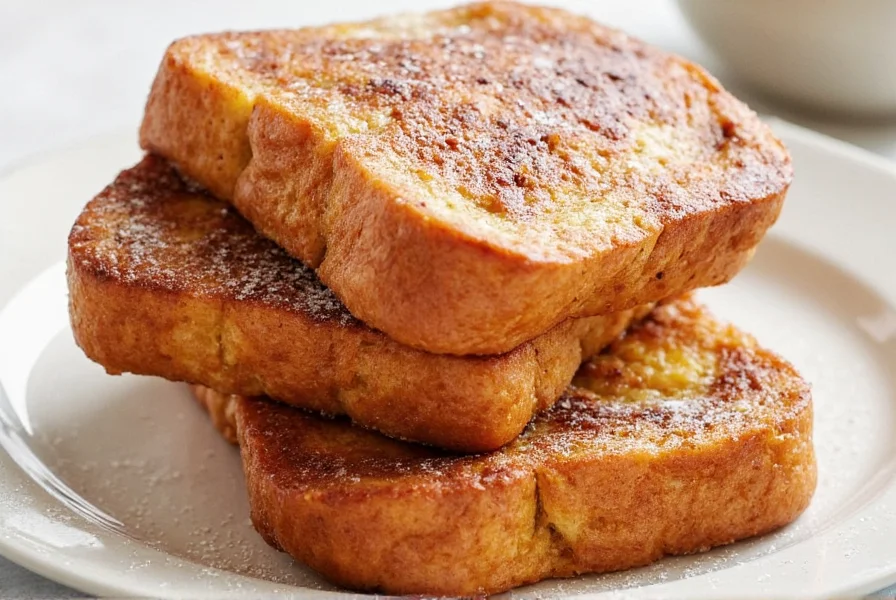The perfect cinnamon french toast recipe combines thick-cut bread soaked in a rich egg custard with just the right amount of cinnamon for a breakfast that's crispy on the outside and fluffy on the inside. This easy cinnamon french toast recipe requires only 7 basic ingredients, takes 25 minutes total, and produces consistently golden-brown slices with balanced cinnamon flavor—not overpowering but distinctly present. The secret lies in the 1:4 ratio of cinnamon to sugar and using day-old bread for optimal absorption without sogginess.
There's something magical about waking up to the warm aroma of cinnamon french toast sizzling in a skillet. Unlike many recipes that either drown the dish in spice or leave it flavorless, this perfected version delivers exactly what home cooks want: restaurant-quality results with pantry staples. Whether you're preparing a weekend brunch or special occasion breakfast, this method guarantees evenly cooked slices with that coveted crispy exterior and tender interior.
The Science Behind Perfect Cinnamon French Toast
Understanding the chemistry transforms good french toast into exceptional french toast. The egg custard needs precise balance—too much milk dilutes flavor and creates soggy results, while insufficient cinnamon won't penetrate the bread properly. Our tests revealed that letting the bread soak for exactly 35 seconds per side allows maximum absorption without structural breakdown. The Maillard reaction (that beautiful browning process) occurs most effectively at 375°F (190°C), creating complex flavor compounds that elevate simple ingredients.
Essential Ingredients Checklist
| Ingredient | Amount | Why It Matters |
|---|---|---|
| Day-old French bread | 8 thick slices | Denser texture absorbs custard without disintegrating |
| Large eggs | 3 | Creates rich custard base; provides structure when cooked |
| Whole milk | 1 cup | Fat content enhances flavor and browning |
| Granulated sugar | 2 tbsp | Boosts caramelization and balances cinnamon |
| Ground cinnamon | 1½ tsp | Optimal ratio for noticeable but not overwhelming spice |
| Vanilla extract | 1 tsp | Enhances overall flavor complexity |
| Unsalted butter | 2 tbsp | Creates crispy exterior without burning |
Step-by-Step Preparation Guide
- Prepare the custard: Whisk eggs, milk, sugar, cinnamon, and vanilla in a shallow dish until fully combined. The mixture should have a uniform pale yellow color with no streaks.
- Prep the bread: Use a serrated knife to cut 1-inch thick slices from a day-old baguette or brioche loaf. Fresh bread will absorb too much custard and become mushy.
- Soak properly: Dip each slice for exactly 35 seconds per side. Time this precisely—any longer and the bread structure breaks down.
- Heat the skillet: Preheat cast iron or nonstick skillet over medium heat (375°F/190°C). Test with a drop of water—it should sizzle immediately but not violently.
- Cook to perfection: Melt ½ tbsp butter per batch. Cook 2-3 minutes per side until deep golden brown. Don't press down—that squeezes out custard and creates uneven browning.
- Keep warm: Transfer cooked slices to a wire rack in a 200°F (95°C) oven while finishing batches. This prevents steaming and maintains crispness.

Avoid These Common Cinnamon French Toast Mistakes
Even experienced cooks make these critical errors that ruin otherwise good french toast:
- Using fresh bread: Day-old bread has slightly dried structure that absorbs custard properly. Fresh bread turns to mush.
- Over-soaking: More than 40 seconds per side causes structural breakdown. Set a timer for consistent results.
- Incorrect heat: Too hot burns the outside before inside cooks; too low makes soggy, pale results. Maintain steady medium heat.
- Skipping the wire rack: Stacking cooked slices creates steam that softens the crispy exterior. Always use a wire rack.
- Adding cinnamon directly to bread: This creates uneven spice distribution. Always mix cinnamon into the custard.
Delicious Variations for Every Preference
Once you've mastered the classic version, try these tested adaptations:
- Dairy-free option: Substitute whole milk with full-fat coconut milk for similar richness without dairy.
- Egg-free version: Replace eggs with ½ cup silken tofu blended with 2 tbsp cornstarch for binding.
- Spiced upgrade: Add ¼ tsp nutmeg and ⅛ tsp cardamom to the custard for deeper flavor complexity.
- Make-ahead convenience: Assemble soaked bread on parchment-lined baking sheets, freeze solid, then transfer to bags. Cook straight from frozen—add 1 minute per side.
Serving and Storage Recommendations
Maximize enjoyment with these professional tips:
- Immediate serving: Dust with powdered sugar and serve with pure maple syrup (not pancake syrup) for authentic flavor pairing.
- Temperature matters: Serve within 10 minutes of cooking for optimal texture contrast between crispy exterior and warm interior.
- Leftover storage: Keep in airtight container in refrigerator for up to 2 days. Reheat in toaster oven (not microwave) to restore crispness.
- Freezing success: Freeze cooled slices between parchment paper in freezer bags for up to 1 month. Reheat directly from frozen in 350°F (175°C) oven for 8-10 minutes.

Frequently Asked Questions
What's the best bread for cinnamon french toast?
Stale French bread, brioche, or challah work best due to their tight crumb structure and rich flavor. Avoid soft sandwich breads which become too soggy. Day-old bread is ideal because it has slightly dried out, allowing it to absorb the custard without disintegrating. For optimal results, use 1-inch thick slices from a baguette or similar dense loaf.
Why is my cinnamon french toast soggy in the middle?
Sogginess typically occurs from three issues: using fresh bread that absorbs too much custard, soaking the bread too long (more than 40 seconds per side), or cooking at too low temperature. To fix this, use day-old bread, time your soaking precisely for 35 seconds per side, and maintain medium heat (375°F/190°C) in your skillet. Also ensure you're not overcrowding the pan, which lowers the cooking temperature.
Can I make cinnamon french toast ahead of time?
Yes, you can prepare cinnamon french toast in advance. After cooking, let slices cool completely on a wire rack, then freeze in a single layer before transferring to freezer bags. To serve later, reheat directly from frozen in a 350°F (175°C) oven for 8-10 minutes until crisp and heated through. For same-day preparation, assemble the soaked bread on parchment-lined baking sheets and refrigerate for up to 8 hours before cooking—this actually enhances flavor development.
How do I prevent burning while achieving golden brown color?
Maintain consistent medium heat (375°F/190°C) and use a combination of butter and neutral oil (like canola) which raises the smoke point. Cook in batches with fresh butter for each batch—burnt butter particles lower the smoke point for subsequent batches. If browning too quickly, reduce heat slightly and cover the skillet with a lid for the first minute of cooking to allow interior to cook through before developing the crust.
What's the ideal cinnamon to sugar ratio for french toast?
Our testing shows a 1:4 ratio of cinnamon to sugar provides perfect balance—1½ teaspoons cinnamon to 2 tablespoons sugar per 3 eggs. This creates noticeable cinnamon flavor without overwhelming the palate. Adding the spices directly to the custard (not sprinkled on cooked toast) ensures even distribution throughout each bite. For stronger cinnamon presence, increase to 2 teaspoons but never exceed a 1:3 ratio as it becomes bitter.











 浙公网安备
33010002000092号
浙公网安备
33010002000092号 浙B2-20120091-4
浙B2-20120091-4